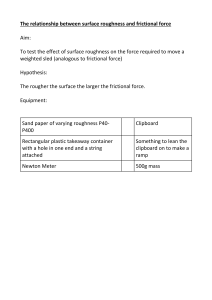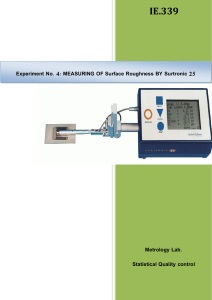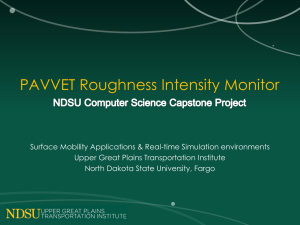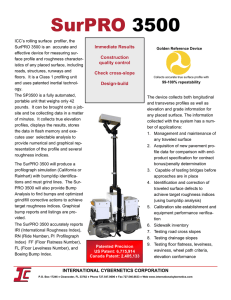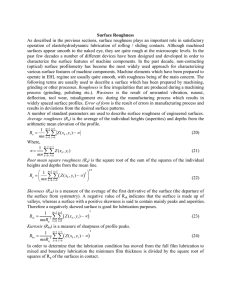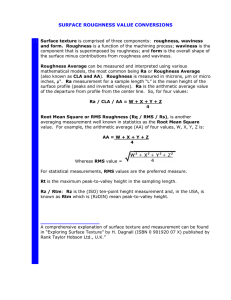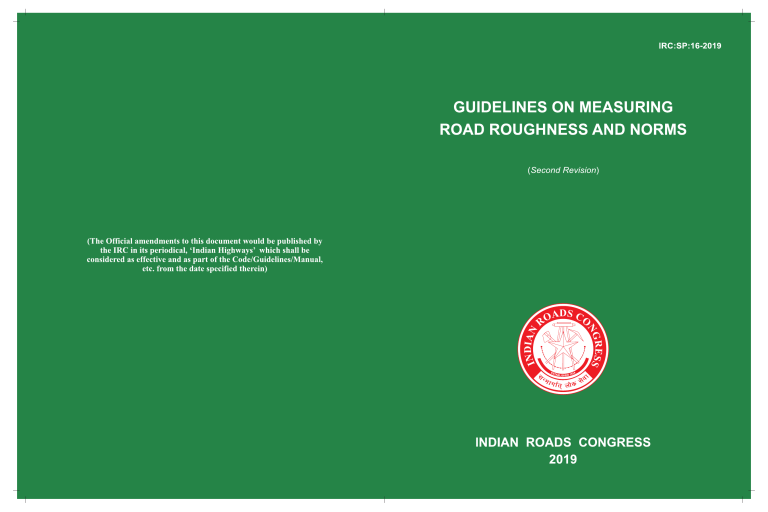
IRC:SP:16-2019 GUIDELINES ON MEASURING ROAD ROUGHNESS AND NORMS (Second Revision) Published by: INDIAN ROADS CONGRESS Kama Koti Marg, Sector-6, R.K. Puram, New Delhi-110 022 August, 2019 Price : ` 400/(Plus Packing & Postage) IRC:SP:16-2019 First Published : March, 1997 First Revision : June, 2004 Reprinted : February, 2007 Reprinted : June, 2009 Reprinted : February, 2016 Second Revision : August, 2019 (All Rights Reserved. No part of this publication shall be reproduced, translated or transmitted in any form or by any means without the permission of the Secretary General, Indian Roads Congress) Printed by India Offset Press, Delhi - 110 064 600 Copies IRC:SP:16-2019 Contents S. No. Description Personnel of the Highways Specifications and Standards Committee 1. 2. 3. 4. 5. Page No. i-ii Introduction 1 1.1 Background 2 1.2 Importance of Road Roughness 4 Road Roughness: Definition, Classification and Methods 7 2.1 Definition of Road Roughness 7 2.2 Roughness Measurement Methods 7 2.3 Classification of Road Roughness Measuring Systems 7 Roughness Standards: Units and Norms 9 3.1 Units For Measuring Roughness 9 3.2 Roughness Norms 9 Roughness Measurements, Analysis and Reporting 12 4.1 Selection of Appropriate Equipment 12 4.2 Field Measurement of Roughness 12 4.3 Data Analysis and Reporting 14 Data Quality: Calibration of Equipment 15 5.1 Calibration of Road Roughness Measuring Equipment 15 5.2 Calibration of Profile Based Roughness Measuring Equipment 16 References17 Appendix-1 Equipments for Road Roughness Measurement 18 IRC:SP:16-2019 PERSONNEL OF THE HIGHWAYS SPECIFICATIONS AND STANDARDS COMMITTEE (HSS) (As on 23.10.2018) 1 Singh, B.N. (Convenor) Director General (Road Development) & Special Secretary to Govt. of India, Ministry of Road Transport and Highways, New Delhi 2 Balakrishna, Y. (Co-Convenor) Additional Director General, Ministry of Road Transport and Highways, New Delhi 3 Kumar, Sanjeev (Member-Secretary) Chief Engineer (R) S, R & T, Ministry of Road Transport & Highways, New Delhi Members 4 Behera, Bijan Kumar Engineer-in-Chief (Civil), Odisha 5 Bose, Dr. Sunil Head (Retd.), FPC Division, Central Road Research Institute, New Delhi 6 Chandra, Dr. Satish Director, Central Road Research Institute, New Delhi 7 Gupta, D.P. DG(RD) & AS (Retd.), Ministry of Road Transport and Highways, New Delhi 8 Jain, R.K. Chief Engineer (Retd.), PWD Haryana 9 Kapila, K.K. Chairman & Managing Director, ICT Pvt. Ltd., New Delhi 10 Kukrety, B.P. Associate Director, CEG Ltd., New Delhi 11 Kumar, Dr. Mahesh Engineer-in-Chief (Retd.), PWD (B&R) Haryana 12 Lal, Chaman Engineer-in-Chief (Retd.), PWD Haryana 13 Meena, H.L. Secretary (Retd.), PWD Rajasthan 14 Nashikkar, J.T. Secretary (Retd.), PWD Maharashtra 15 Nirmal, S.K. Secretary General, Indian Roads Congress, New Delhi 16 Pandey, I.K. Additional Director General, Ministry of Road Transport and Highways, New Delhi 17 Parida, Prof. (Dr.) M. Dean, SRIC, Indian Institute of Technology, Roorkee 18 Patel, S.I. Secretary (Retd.), PWD (Roads and Buildings) Gujarat 19 Prasad, R. Jai Engineer-in-Chief (Retd.), PWD & Bangalore Mahanagar Palike, Karnataka 20 Rawat, M.S. Executive Director, AECOM India Pvt. Ltd. 21 Reddy, Dr. K.S. Krishna Secretary, Public Works, Ports & Inland Water Transport Department, Karnataka 22 Reddy, I.G. Engineer-in-Chief (NH, CRF & Buildings), PWD Hyderabad 23 Reddy, Prof. (Dr.) K.S. Professor, Indian Institute of Technology, Kharagpur 24 Sharma, S.C. DG(RD) & SS (Retd.), Ministry of Road Transport and Highways, New Delhi 25 Shrivastava, A.K. Additional Director General (Retd.), Ministry of Road Transport and Highways, New Delhi 26 Singh, Nirmaljit DG(RD) & SS (Retd.), Ministry of Road Transport and Highways, New Delhi i IRC:SP:16-2019 27 Sinha, A.V. DG(RD) & SS (Retd.), Ministry of Road Transport and Highways, New Delhi 28 The Chief Engineer (Basar, Toli) PWD Arunachal Pradesh 29 The Chief Engineer (Kumar, Anil) Border Roads Organisation, New Delhi 30 The Director (Tech.) (Pradhan, B.C.) National Rural Infrastructure Development Agency, New Delhi 31 The General Manager (Projects) Retd. (Kaul, Satish) National Highways and Infrastructure Development Corporation, New Delhi 32 The JICA Expert (Kitayama, Michiya) Japan International Cooperation Agency, New Delhi 33 The Member (Projects) (Pandey, R.K.) National Highways Authority of India, New Delhi 34 Indian Institute of Technology, Kanpur The Professor (Chakroborty, Dr. Partha) 35 The Secretary (Vasava, S.B.) Roads and Buildings Department, Gujarat 36 The Secretary (Roads) (Joshi, C.P.) PWD Maharashtra 37 The Secretary (Tech.) (Tickoo, Bimal) (Retd.) Roads and Buildings Department, Jammu & Kashmir 38 The Special Director General (Retd.) (Bansal, M.C.) CPWD, Nirman Bhawan, New Delhi 39 Venkatesha, M.C. Consultant 40 Wasson, Ashok Member (Tech.) (Retd.), National Highways Authority of India, New Delhi Corresponding Members 1 Jaigopal, R.K. MD, Struct Geotech Research Laboratories (P) Ltd., Bengaluru 2 Justo, Prof. (Dr.) C.E.G. Professor (Retd.), Emeritus 3 Veeraragavan, Prof. (Dr.) A. Professor, Indian Institute of Technology, Madras Ex-Officio Members 1 President, Indian Roads Congress (Reddy, Dr. K.S. Krishna), Secretary, Public Works, Ports & Inland Water Transport Department, Karnataka 2 Director General (Road (Singh, B.N.), Ministry of Road Transport and Highways, New Delhi Development) & Special Secretary to Govt. of India 3 Secretary General, Indian Roads Congress Nirmal, Sanjay Kumar ii IRC:SP:16-2019 GUIDELINES ON MEASURING ROAD ROUGHNESS AND NORMS 1. INTRODUCTION Surface evenness of highway pavements refers to the regularity of surface finish both in longitudinal and transverse directions. Almost in all major highway works executed, control of surface evenness has been introduced as mandatory requirement. Based on 1975 report of IRC Sub-Committee of Surface Characteristics of Pavements under Convenorship of Shri Mahabir Prasad, IRC has brought out Special Publication No. 16 in 1977. The document was used widely by highway professionals as it describes existing standards and tolerances of surface evenness. These guidelines were revised in the year 2004 to incorporate improved and observed values of surface evenness and roughness of wearing surface of highway pavements due to introduction of high level of sophistication and mechanization in road construction. The second (current) revision has been done based on the feedback received from the industry as well as advancement in the technology, machinery and material. The initial draft was prepared by the subgroup comprising Shri Ashok Wasson, Shri K. Sitaramanjaneyulu, Shri M.N. Nagabhushana, Dr. Pradeep Kumar and Shri Neeraj Chadha members of Road Maintenance and Asset Management Committee. The draft was deliberated in several meetings of H-6 Committee and was finalized in its meeting held on 6th October, 2018. The revised draft was placed before the Highways Specifications and Standards Committee (HSS) in its meeting held on 23rd October, 2018. The HSS Committee approved the draft subject to the consideration of the observations of members. The Executive Committee in its meeting held on 27th October, 2018 approved the draft for placing before the Council of IRC. The Council in its 216th meeting held on 22nd November, 2018 at Nagpur (Maharashtra) considered and approved the same for printing. The composition of H-6 Committee is as given below: Kumar, Dr. Mahesh …….. Convenor Sitaramanjaneyulu, K. …….. Co-Convenor Nagabhushana, M.N. …….. Member-Secretary Members Chadha, Neeraj Sharma, S.C. Gupta, D.P. Singh, Mahabir Kukrety, B.P. Singh, Nirmaljit Kumar, Atul Swamy, Prof. (Dr.) A.K. Kumar, Dr. Ashok Vasava, Sandeep Kumar, Dr. Pradeep Wasson, Ashok Pal, Dr. N.C. MoRTH (Sharma, Vipnesh) 1 IRC:SP:16-2019 Pandey, R.K. BRO (Sawhney, Col. J.S.) Raju, D. Shiva Director, HRS (Geeta, R.) Ransinchung R.N., Prof. (Dr.) G.D. Director (Tech.), NRRDA Rao, P.R. (Pateriya, Dr. I.K. upto July, 2018 thereafter Pradhan, B.C.) Rao, R.V. Corresponding Members Amarnath, Prof. (Dr.) M.S. Pradhan, N.K. Justo, Prof. (Dr.) C.E.G. Singh, Prof. (Dr.) Dharamveer Veeraragavan, Prof. (Dr.) A. Ex-Officio Members 1.1 President, Indian Roads Congress (Reddy, Dr. K.S. Krishna), Secretary, Public Works, Ports & Inland Water Transport Department, Karnataka Director General (Road Development) & Special Secretary to Govt. of India (Singh, B.N.), Ministry of Road Transport & Highways Secretary General, Indian Roads Congress Nirmal, Sanjay Kumar Background Surface evenness/roughness of a road is an important parameter for the evaluation of surface condition of road and hence forms an important input into any Pavement Maintenance Management System (PMMS) towards deciding upon the optimal maintenance strategies to be applied within the given budget. An increase in road roughness results in higher road user costs and uncomfortable ride inviting criticism from the traveling public. As has been well established, the economic impact of road roughness is significant. Even a small improvement in the surface evenness or in other words the reduced roughness can yield high economic returns as the total operating cost of all vehicles outweigh the agency cost and maintenance cost for a given road. These returns are not immediately apparent to a highway agency since most of these benefits accrue to the road users. On the other hand, the consequences of neglected maintenance are immediately experienced by the users in terms of high operating cost, increased travel time and high accident rate etc. However, it needs to be borne in mind that if through assured maintenance, road roughness can be contained to lower levels, the road agencies would also benefit through deferred reconstruction investments. 2 IRC:SP:16-2019 The relationships between vehicle operating cost and road roughness are well established through several studies conducted both in India and abroad. These studies have quantified the impact of road geometrics and roughness on the components of operating costs such as fuel (energy efficiency), tyres, spare parts, depreciation, travel time and vehicle speed. Road roughness, therefore emerges as a key characteristic of the road condition which should be duly considered in developing maintenance standards and for fixing the level of serviceability required for the purpose of economic evaluation and energy efficiency. The PIARC Technical Committee on surface characteristics has specified frequency domains for various surface characteristics as given in Table-1.1 (Descornet, 1990). The frequency range for roughness is that which induces relative motion in road vehicle suspension systems over a reasonable range of operating speeds. Road users can identify different types of roughness, such as the various forms of unwanted vehicle vibration. It is reasonable to compute more than one roughness index from a profile, if the different indices provide independent information about the state of the road. All types of roughness are not unique. Table 1.1 PIARC Specification of Frequency Ranges for Road Surface Characteristics (Descornet, 1990) Surface Characteristic Frequency Range Wave Length Wave Number (cycle/m) Micro texture < 0.5 mm >2000 Macro texture 0.5 – 50 mm 20 – 2000 Mega texture 50 – 500 mm 2 – 20 Roughness 0.5 – 50 m 0.02 – 2 Different types of roughness are associated with different wavelengths. For example, vehicle manufacturers are concerned with different aspects of ride, ranging from the heaving motions that mainly involve suspension movement, to audible noise involving acoustics of the body. These are caused by widely different wavelength ranges. (The vehicle body motions are due to wavelengths of the order of 15 meters, whereas the noise involves wavelengths shorter than 1 meter.) Roughness analyses can be compared on the basis of how they process a sinusoid. Most of the analyses filter out very long wavelengths and very short wavelengths (Sayers et al, 1998). Roughness involves at least two dimensions in a complex way, as it involves variation of profile height along its length. There are two systems for measuring road roughness. A system that measures or bases the measurements on the profiles of the road is termed as profilometric systems. Systems that rely on the movement of a suspension system in response to the unevenness of the road surface travelled by a vehicle are termed as Response Type Road Roughness Measuring System (RTRRMS). 3 IRC:SP:16-2019 1.2 Importance of Road Roughness 1.2.1 Effect on Road Safety For many years, the ride experienced by the occupant of a vehicle has been used as a criterion of pavement roughness. A person travelling on a vehicle at a selected speed subjectively evaluates the riding experience. The vibration of the vehicle induced by road roughness affects driver performance. It has been reported by human factors researchers that continuous exposure to vibration may induce fatigue, which may in turn be a factor that contributes to accidents. It is mentioned that vehicle suspension also plays a role in the effect of roughness on safety. Frequency has a major effect on automobile and trucks that can cause safety problems. When roughness occurs at a repeated amplitude and frequency, it can have two effects. First, if the frequency is in phase with the vehicle, a rough road can seem to be smooth. Second, if the roughness is out of phase with the natural frequency, the roughness can be magnified. This phenomenon causes a problem when repeated upward forces continually reinforce already existing upward forces of the vehicle. When this occurs, the vehicle starts to move up and down with the roadway in ever increasing movements until the car or truck tyres actually leave the roadway and become airborne. The roughness of the pavement causes change in the normal forces that act at the tyre-pavement interface and affects the lateral forces needed to control a vehicle, thereby influencing the steering capabilities of the vehicle. On relatively smooth pavements, the variation in normal force is very small. However, on rough pavements, these variations can be very large and reduce significantly the lateral force available to control the vehicle. In situations where high lateral forces are necessary or where a vehicle requires a particular lateral friction level to make a manoeuvre, this loss of force could lead to loss of control of the vehicle. Roughness can cause significant loss of braking force or slip resistance on a vehicle. In addition to this, problems can arise due to variation of roughness in each of the wheel tracks of a lane. These differences of roughness in each wheel path cause differences in the braking and sliding forces that act on the vehicle. This will cause the exposure of vehicle to different levels of friction on each side, which can result in a significant safety problem. 1.2.2 Effect on Vehicle Operating Cost The Vehicle Operating Cost (VOC) components consist of fuel consumption, oil consumption, tyre wear, maintenance and repair, and depreciation. Road surface roughness is one of the factors determining Vehicle Operating Cost (VOC). Roughness affects the amount of fuel consumed in vehicles. While increasing roughness increases fuel consumption at any given speed and reduces travel speed. In Highway Development and Management Model, HDM-4, effect of International Roughness Index (IRI) on Vehicle Operating Cost (VOC) was studied, by a set of notional 1km road lengths with IRI ranging from 2 to 2.5 in increments of IRI 0.5. The result of the study is shown in Fig. 1.1. 4 IRC:SP:16-2019 (Source: Parkman et al, 2012) Fig. 1.1 Variation of Vehicle Operating Cost with IRI (HDM 4) It is important to analyse the relationship between roughness and speed, as well as speed and fuel to determine the relationship between fuel consumption and roughness at variable speed. Various studies examining the roughness-speed relation have established a negative correlation between the two as roughness serves to decrease ride comfort and drivers reduce their speed accordingly. HDM models shows that at low speed, increasing speed serves to decrease distance-related fuel consumption because a greater distance is covered during each unit of time-related fuel consumption. Repair and maintenance cost also gets affected by road roughness. 1.2.3 Effect on Vehicle Riding Comfort Vehicle’s ride quality varies with travel speed, the dynamic characteristics of the vehicle, and the spectral characteristics of the roughness of the road. Assessment of ride quality and road roughness by measuring the response of a vehicle is dependent on travelling speed and dynamic characteristics of the vehicle. To obtain repeatable and reproducible measurements of ride quality, the measuring speed required to be controlled. Depending on the type of instrument and application, the measurement speed ranges from 20 to 80 km/h. 1.2.4 Effect on Vehicle Speed The effect of road roughness on traffic speed has been statistically quantified in a generalized speed prediction model under free-flow conditions. 5 IRC:SP:16-2019 Derived on the basis of probabilistic limiting velocities, the model may be expressed in the following form: V = K0 / [∑Vi(1/β) ]β Eqn. 1.1 V = predicted vehicle speed, km/h; β = estimated parameter (within a range of 0.25 to 0.33); K0 factor for correcting the bias introduced on converting the model from the originally estimated logarithmic form to an antilogarithmic form (slightly larger than unity); and Vi = limiting speed for ith speed constraint, i = 1 to 5, in km/h; where V1 is the maximum possible uphill speed, dependent mainly on the road gradient and engine power; V2 is the maximum allowable downhill speed before the speed increases beyond control and is dependent mainly on the road gradient and vehicle braking capability; V3 is the maximum allowable curve speed, dependent mainly on the radius of horizontal curvature, the super elevation, and the surface type; V4 is the desired speed, in the absence of other constraints and limited by subjective factors such as safety, speed limit etc.; and V5 is the maximum allowable ride comfort speed. 6 IRC:SP:16-2019 2. ROAD ROUGHNESS: DEFINITION, CLASSIFICATION AND METHODS 2.1 Definition of Road Roughness Road roughness is the result of either the built-in-irregularities due to construction defects/ deficiencies or it may also appear on the road surface due to the consolidation or displacement of different materials placed within the pavement structure due to traffic movement. Road roughness is the deviations of the pavement surface from a true planar surface with characteristic dimensions that affect vehicle dynamics, ride quality, dynamic loads, and drainage, for example, longitudinal profile, transverse profile, and cross slope (ASTM E867). 2.2 Roughness Measurement Methods 2.2.1 Profilometric Systems Systems that measure or base their measurements on the profiles of road are, generally termed as profilometric system. When profile is measured, the continuous representation of the road can be inspected to identify local defects, or processed to yield roughness numeric adapted to specific applications. The details of some of these equipment are given in Appendix-1. 2.2.2 Response Type Road Roughness Measuring System (RTRRMS) As early as the 1920s, highway engineers installed devices in cars to record suspension stroke as a measure of roughness. These were called road meters and had several generic names, including: Response-Type Road Roughness Measuring Systems (RTRRMS), response-type systems, and road meter systems. In these systems, the vehicle is a passenger car, a van, a light truck, or a special trailer. A road meter is a transducer that accumulates suspension motions. Nearly the entire road meter designs follow the concept of the Bureau of Public Roads (BPR) Roughometer, and accumulate deflections of the vehicle suspension as it travels down the road. The BPR Roughometer is a single-wheel trailer with a one-way clutch mechanism that accumulates the suspension stroke in one direction. The roughness measure that is obtained is “inches” of accumulated suspension stroke, normalized by the distance travelled. The measure is usually reported with engineering units such as inches per mile (in/mi) or meter per kilometre (m/km), although sometimes other units are used based on the instrumentation hardware, e.g., “counts/mi.” The various equipment such as Fifth Wheel Bump Integrator or Automatic Road Unevenness Recorder (indigenously developed by CRRI, India), Car Axle Mounted Bump Integrator and Accelerometer based systems falls under this category. Refer Appendix-1 for details. 2.3 Classification of Road Roughness Measuring Systems Instruments used for the collection of roughness data are characterised into four classes as defined by Sayers et al. 2.3.1 Class 1: Precision Profilers Precision profilers are the instruments that provide the highest standard of accuracy for calculating IRI and are a series of accurately measured elevation points, closely spaced along 7 IRC:SP:16-2019 the section (i.e. with a short sampling interval). The elevations are measured at sampling intervals not more than 250 mm with a precision of less than 0.5 mm on very smooth pavements using walking speed profilometers. However, for high speed road profilers such as Laser Profilometer (ASTM E950 Class-1 Compliance) the longitudinal sampling interval is ≤ 25 mm with a vertical measurement resolution of ≤ 0.1 mm. 2.3.2 Class 2: Other Profilometer Methods An instrument not capable of meeting the Class 1 requirements for precision, or sampling interval, may meet the criteria for Class 2. The Class 2 sampling intervals are set at a maximum of 500 mm with a precision on smooth roads of below 1 mm for using walking speed profilometers. However, for high speed road profilers the longitudinal sampling interval is > 25 mm to 150 mm with a vertical measurement resolution of > 0.1 mm to 0.2 mm. 2.3.3 Class 3: Response Type Measurements All Response Type Road Roughness Measuring System (RTRRMS) belongs to this category of roughness measurement. RTRRMSs measure the dynamic response of vehicles to the road surface by using either mechanical or accelerometer devices. The estimation of roughness index for RTRRMS is made using correlation equation after calibration with Class-1 road profiler. 2.3.4 Class 4: Subjective Ratings In subjective evaluations of roughness, the investigator physically drives along the road or makes a visual survey. 8 IRC:SP:16-2019 3 ROUGHNESS STANDARDS: UNITS AND NORMS 3.1 Units for Measuring Roughness Different measuring systems/practices have different units for representing the measured roughness, as discussed below. 3.1.1 Roughness Index (RI) The pavement surface roughness is expressed as Unevenness or Roughness Index (in mm/ km) measured through Fifth Wheel Bump Integrator or Car Axle Mounted Bump Integrator. 3.1.2 International Roughness Index (IRI) It is the reference average rectified slope, which expresses the ratio of the accumulated suspension motion of a vehicle, divided by the distance travelled during the test. The recommended unit of IRI is m/km. 3.1.3 Correlation between IRI and RI For correlation with RI values obtained from RTRRMS equipment such as Fifth Wheel Bump Integrator and Car Axle Mounted Bump Integrator, the following Eqn. (2.1) may be used for IRI < 17 (Paterson, 1990): RI = 630 (IRI)^1.12(2.1) Where, RI = Roughness Index in mm/km and IRI = International Roughness Index in m/km 3.2 Roughness Norms In all major road works executed, control of surface evenness during construction phase has been stipulated as a mandatory requirement. The standard recommended for surface evenness enables the engineer-in-charge to exercise control over the quality of construction. The longitudinal profile shall be checked with a 3-metre straight edge at the middle of each traffic lane along a line parallel to the central line of the road and shall comply with maximum permitted number of surface irregularities as per “Specifications for Roads and Bridge Works”, Ministry of Road Transport and Highways (Section 902, Table 900-2). The recommended maximum permissible surface unevenness values in terms of Roughness Index in mm/km and International Roughness Index in m/km are given in Table 3.1, 3.2 and 3.3 for various categories of roads. It is recommended that all the newly constructed roads shall meet the criteria of roughness values as per “Good” surface condition. The roughness values under “Fair” and “Poor” surface condition of roads has been indicated for purposes of timely maintenance planning and interventions. 9 IRC:SP:16-2019 Table 3.1 Maximum Permissible Values of Roughness for Expressways, National Highways and State Highways Condition of Road Surface S. No. Type of Surface Good Fair RI IRI RI 1 Bituminous (BC, SMA, SDBC) <1800 <2.55 2 Cemented <2000 <2.81 Poor IRI RI IRI 1800-2400 2.55-3.30 >2400 >3.30 2000-2400 2.81-3.30 >2400 >3.30 Note: In case of four lane divided and above corridors, roughness measurements shall be carried out using Class 1 equipment. For other corridors, the roughness measurements shall be carried out using Class 1/Class 2 or Class 3 equipment depending upon survey speed/geometric suitability. Table 3.2 Maximum Permissible Values of Roughness for Major District Roads and Other District Roads Condition of Road Surface S. No. Type of Surface Good Fair RI IRI RI Poor IRI RI IRI 1 Surface Dressing <3000 <4.03 3000-3800 4.03-4.98 >3800 >4.98 2 Open Graded Premix Carpet <2800 <3.79 2800-3500 3.79-4.62 >3500 >4.62 3 Mix Seal Surfacing <2600 <3.55 2600-3200 3.55-4.27 >3200 >4.27 4 Semi Dense Bituminous Concrete <2200 <3.05 2200-3000 3.05-4.03 >3000 >4.03 5 Bituminous Concrete <2000 <2.81 2000-2600 2.81-3.55 >2600 >3.55 6 Cement Concrete <2200 <3.05 2200-2600 3.05-3.55 >2600 >3.55 Note: Roughness measurements shall be carried out using Class 1/Class 2 or Class 3 equipment on 10 IRC:SP:16-2019 these categories of roads depending upon survey speed/geometric suitability. Table 3.3 Maximum Permissible Values of Roughness for Village Roads S. No. Type of Surface 1 Condition of Road Surface Good Fair RI IRI Surface Dressing <3200 <4.27 2 Open Graded Premix Carpet <3000 3 Mix Seal Surfacing RI Poor IRI RI IRI 3200-3800 4.27-4.98 >3800 >4.98 <4.03 3000-3500 4.03-4.62 >3500 >4.62 <2800 <3.79 2800-3200 3.79-4.27 >3200 >4.27 4 Semi Dense Bituminous Concrete <2400 <3.30 2400-3000 3.30-4.03 >3000 >4.03 5 Cement Concrete <2200 <3.05 2200-2600 3.05-3.55 >2600 >3.55 Note: Roughness measurements shall be carried out using Class 1/Class 2 or Class 3 equipment on these categories of roads depending upon survey speed/geometric suitability. 11 IRC:SP:16-2019 4. ROUGHNESS MEASUREMENTS, ANALYSIS AND REPORTING 4.1 Selection of Appropriate Equipment The use of FWBI/ARUR or CAMBI or any other new technology equipment for measuring road roughness mainly depends upon the road network/area to be covered for the survey. For selection of appropriate roughness measuring device, the following points may be considered. • For roughness measurements in plain terrain areas, where the condition of roads is average to poor and average traffic speed is about 30 to 40 kmph (like on MDRs, ODRs and Village Roads), then under such conditions FWBI/ARUR, CAMBI can serve the purpose for roughness measurements, as in these areas, the standard survey speed of 32 kmph can be conveniently maintained. In such situations, the high speed and sophisticated survey equipment such as laser Profilometer may not be insisted. • On high speed road corridors (Expressways, National Highways and State Highways) where the average traffic speed is more (say >= 60 kmph), the use of slow speed equipment shall be avoided, due to safety reasons. The Laser Profilometer (LP) and Ultrasonic Sensor Based Profilometer are recommended for roughness measurements on these high-speed road corridors. • For rolling and hilly terrain areas, it is difficult to maintain the constant survey speed of 32 kmph which is essential for response type roughness measuring systems, Also, due to high gradients and frequent sharp curves in these areas, the use of FWBI/ARUR (which is a towing type device) is not recommended. In such conditions, CAMBI are preferred types of equipment and are recommended for use with a range of calibration curves at different survey speeds, say from 10 to 32 kmph. • Laser Profilometer, Ultrasonic Sensor Based Profilometer, Car Axle Mounted Bump Integrator and Accelerometer Based equipment are recommended to be used for the roads where average traffic speed is 40 to 60 kmph. 4.2 Based on the above considerations, recommendations for selection of appropriate roughness measuring equipment in different operating conditions are given in Table 4.1. Field Measurement of Roughness Measurement of roughness shall be conducted using a suitable roughness measuring equipment as per Table 4.1. The equipment shall be calibrated/validated, and the survey shall be conducted under standard operating conditions of the respective equipment. The guidelines to carry out the survey based on pavement width are presented in Table 4.2. 12 IRC:SP:16-2019 Table 4.1 Recommendations for Selection of Appropriate Roughness Measuring Equipment in Different Operating Conditions Operating Conditions (Measurement Speed) Low (from 10 kmph to 40 kmph) Medium (> 40 kmph to 60 kmph) High (> 60 kmph) Terrain Terrain Terrain Plain Rolling Hilly FWBI/ ARUR and CAMBI FWBI/ ARUR and CAMBI CAMBI (With multiple speed calibration) Plain Rolling Hilly LP, USBP, CAMBI, AB Plain Rolling LP and USBP Hilly Not Applicable Table 4.2 Guidelines for Measurement Equipment Single Lane Intermediate Lane Double Lane Multiple Lane FWBI/ARUR/ Single Run CAMBI (One Direction) Single Run (Each Direction) Single Run (Each Lane) Single Run (Each Lane) LP/USBP Single Run (One Direction) Single Run (Each Direction) Single Run (Each Lane) Single Run (Each Lane) AB Single Run (One Direction) Single Run (Each Direction) Single Run (Each Lane) Single Run (Each Lane) Where LP = Laser Profilometer (ASTM E950 Class-1 Compliance) USBP = Ultrasonic Sensor Based Profilometer FWBI = Fifth Wheel Bump Integrator ARUR = Automated Road Unevenness Recorder CAMBI = Car Axle Mounted Bump Integrator AB = Accelerometer Based Equipment Note: 1) For roughness measurements using FWBI/ARUR the fifth wheel should preferably travel on wheel path. For measurement of roughness, one measurement in each lane is recommended. For roughness measurements using CAMBI, it should be ensured that the outer vehicle wheel travels on the wheel path. 13 IRC:SP:16-2019 2) 4.3 Walking speed type Class-1 equipment (which are not included in Table 4.1) are normally used for calibration of RTRRMS equipment and validation of Roughness data. However, the measurement using these equipment can only be recommended under no traffic conditions/closed road conditions in case of very small road stretches (<1 km length) for calibration of Class-3 equipment and research and development activities. Data Analysis and Reporting The data shall be analysed as per the standard procedure of the respective equipment. The roughness data shall be reported/presented as per the details given in Table 4.3. Table 4.3 Guidelines for Roughness Data Reporting Equipment Single Lane Intermediate Lane Double Lane Multiple Lane FWBI/ ARUR/ CAMBI RI or RI or Converted IRI Converted IRI Individual Lane Wise (RI or Converted IRI) Individual Lane Wise (RI or Converted IRI) LP/USBP IRI or Converted RI IRI or Converted RI Individual Lane Wise and Average (IRI or Converted RI) Individual Lane Wise (IRI or Converted RI) AB IRI or Converted RI IRI or Converted RI Individual Lane Wise (IRI or Converted RI) Individual Lane Wise (IRI or Converted RI) 14 IRC:SP:16-2019 5. DATA QUALITY: CALIBRATION OF EQUIPMENT 5.1 Calibration of Road Roughness Measuring Equipment 5.1.1 Guidelines for Calibration of RTRRMS Equipment It is necessary to ensure that the roughness measurements are accurate and reliable. In response type devices such as FWBI/ARUR/CAMBI/AB etc., significant variations may often be encountered in roughness measurement. Thus, in order to ensure repeatability and reproducibility of measurement by the same machine and consistency in measurement from different machines, it is essential that the response of the device to the road surface roughness should be correct. Initial standardization and subsequent recalibration of response type devices are essential. The new measurements obtained from the response type devices must be correct to the standard roughness scale by calibration. Calibration is achieved by obtaining "raw" measures of Average Rectified Slope (the "counts/ km" or other similar number produced as output by the instrument) on special calibration sites. These sites are sections of road that have known IRI roughness values as determined with Class 1 methods. The RTRRMS is periodically run over the calibration sites 3 - 5 times at the standard speed after suitable warm-up. The "raw" values from the RTRRMS are plotted against the IRI values, with the RTRRMS values on the x-axis and the IRI values on the y-axis line is fitted to the data points and used to estimate IRI from RTRRMS measurements taken in the field. The accuracy of the calibrated measures can be seen approximately as the scatter of the points about the fitted line: the smaller the scatter, the better the accuracy. Table 5.1 shows the requirements for RTRRMS calibration sites. A number of test sites, minimum 8 to 10 of straight sections of length 100 m to 200 m, of different roughness level covering a wide range of spectrum of surface roughness ranging from very smooth to very rough (say IRI 2.0 m/km to 12.0 m/km) are selected. Care is taken to ensure that sufficient approach length on either side is available to attain vehicle test speed before entering the starting point of the test section. The entire length of all selected sites should have uniform riding quality and free of surface defects. For better visibility, wheel paths are marked with a road marking paint along with starting and the ending point of the section for data recording. Section roughness and the corresponding reference values of each section are recorded through any of the above mentioned calibration devices for developing the calibration. At each test site, a number of runs are made till at least three sets of consistent data are obtained. Average of the three values is taken as the representative roughness values of the section. 15 IRC:SP:16-2019 Table 5.1 Requirements for RTRRMS Calibration Sites Requirements Nos Minimum number of sites 8 to 10 Minimum site length 100 m Recommended total length (site length x number of sites) 1.0 km Recommended number of repeat RTRRMS measures per site 3 to 5 Minimum approach distance for site (RTRRMS must be brought to speed before entering approach area) 50 m The calibration certificate of RTRRMS equipment shall be issued with the following conditions: 5.2 1. For FWBI/ARUR, the validity of calibration certificate is for two years from the date of calibration or 5000 kms of field measurements, whichever is earlier. If at any stage during the validity period there is any major changes made, the certificate shall be automatically stand invalid and the unit should then be got re-calibrated. 2. For CAMBI and AB equipment, the calibration certificate is valid only along with the survey vehicle used at the time of calibration. The calibration certificate is valid for two years from the date of calibration or 5000 kms of field measurements, whichever is earlier. If at any stage during the validity period there is any major changes made in the equipment or the survey vehicle, the certificate shall be automatically stand invalid and the unit should then be got re-calibrated. Calibration of Profile Based Roughness Measuring Equipment All profile-based roughness measuring equipment have their own in-built calibration procedure. These equipment shall be strictly calibrated as per their standard calibration mechanism and frequency. 16 IRC:SP:16-2019 REFERENCES 1. ASTM:E950/E950M—09 (Reapproved 2018), “Standard Test Method for Measuring the Longitudinal Profile of Travelled Surfaces with an Accelerometer-Established Inertial Profiling Reference”. 2. ASTM E867—06 (Reapproved 2012), “Standard Terminology Relating to VehiclePavement Systems”. 3. Descornet, G. (1990), “Reference Road Surface for Vehicle Testing”, Roads PIARC, No.272 4. Parkman, C.C. and Bradbury T. (2012),”Economic, Environmental and Social Impacts of Change in Maintenance Spend on the Scottish Trunk Road Network”, Transport Research Laboratory, Transport Scotland. 5. IRC:82-2015, “Code of Practice for Maintenance of Bituminous Road Surfaces”, Indian Roads Congress, New Delhi, India. 6. Pradeep Kumar, B.M. Sharma and Y.V. Rao, “Suggestions for Selection of Appropriate Roughness Measuring Equipment in Different Operating Conditions”, Seminar on Roads in High Precipitation Areas, 19-20 February 2010, Guwahati, Assam, India, Page 4-9 to 4-15. 7. Paterson, W. D.O., “Road Deterioration and Maintenance Effects”, (1990), The Highway Design and Maintenance Standards Series, A World Bank Publication. 8. Sayers, M.W., T. D. Gillespie, and W. D. O. Paterson (1986), “Guidelines for Conducting and Calibrating Road Roughness Measurements”, World Bank Technical Paper No. 46. 9. Sayers, M.W. and S. M. Karamihas (1998), “The Little Book of Profiling-Basic Information About Measuring and Interpreting Road Profiles”, University of Michigan, USA. 17 IRC:SP:16-2019 APPENDIX-1 EQUIPMENTS FOR ROAD ROUGHNESS MEASUREMENT 1.Fifth Wheel Bump Integrator (FWBI)/Automated Road Unevenness Recorder (ARUR) Fifth Wheel Bump Integrator (Fig. A.1) is a response type road roughness measuring system. The equipment consists of a trailer towed by a vehicle. A standard pneumatic tyre wheel inflated to a tyre pressure of 2.1 kg/sqm is mounted within the trailer chassis, with a single leaf spring on either side of the wheel supporting the chassis. Two dashpots provide viscous damping between chassis and axle. The frame is provided with a counter weight at the front to make the device practically free from the effects of the vertical motion of the vehicle. A mechanical integrator makes cumulative measurements of the unidirectional vertical movement of the wheel relative to the chassis. The distance travelled is measured by a distance-measuring unit. The test is conducted at a speed of 32±1 km/hour. Roughness Index is defined as the ratio of the cumulative vertical displacement to the distance travelled and is expressed in mm/km. The equipment is driven over the road surface at a speed of 32±1 km/hour, keeping steady motion and avoiding swerving. The readings of the revolution counter and integrating counters are noted or automatically recorded in the data sheet/logger. Fig. A.1 Sketch of Fifth Wheel Bump Integrator The bump integrator values are recorded at preset distance or when the wheel revolution counter records 1000 units which correspond to 1 km. The brief description of the road surface is also noted as the observer travels over the surface. The fifth wheel should preferably travel on wheel path. For measurement of roughness, one measurement in each lane is recommended for riding comforts evaluation. This equipment need to be calibrated and validated with respect to some Class-1 equipment as per the standard procedure. 18 IRC:SP:16-2019 2. Car Axle Mounted Bump Integrator (CAMBI) The Car Axle Mounted Integrator (Fig. A.2) consists of an bump integrating unit as provided in the Fifth Wheel Bump Integrator. The integrating unit is fitted with the rear axle and mounted in the rear portion of the car or rear floor of a jeep. Fig. A.2 Sketch of Car Axle Mounted Bump Integrator The differential movement between the rear axle and the body of the vehicle due to road unevenness is measured by the upward vertical motion of a wire which is transmitted into unidirectional rotator movement of the pulley of the integrator unit. There is an arrangement in the integrating unit for converting the rotational movement into electric pulses, which is recorded by the counters/loggers. One count corresponds to 1 cm relative movement between axle and floor of the vehicle. One count in distance counter corresponds to 1 m length of distance travelled. The road roughness is affected by the vehicle speed. A bump gets magnified if the speed is not maintained. Vehicle load is another factor that influences the roughness measurement. For getting the realistic values, the constant vehicle speed must be maintained (calibration speed) or equipment shall be calibrated for multiple survey speeds. The laden weight of the vehicle is also standardized. While taking measurements, the vehicle should carry maximum three passengers. It should be ensured that the outer vehicle wheel travels on the wheel path. This equipment need to be calibrated and validated with respect to some Class-1 equipment as per the standard procedure. 19 IRC:SP:16-2019 3. Laser Profilometer (LP) Laser based road profiling is a high-speed road roughness measuring system as per ASTM E950 (Class-1 category). The Laser Profilometer beam is installed in the front or back of the survey vehicle. This system is based on the measurement of vertical displacements using Laser Rays. Laser Profilometer Bar comprises of two laser sensors used for the measurement of longitudinal profile of two wheel paths of the pavement surface as shown in Fig. A.3. The system directly gives International Roughness Index (IRI) for both wheel paths viz. Left IRI and Right IRI in terms of m/km. This equipment has self-calibration mechanism. Fig. A.3 Sketch of Laser Profilometer 4. Accelerometer Based (AB) Equipment Equipment based on the principle of measurement of vertical acceleration of the survey vehicle may also be used for the measurement of road roughness index after due calibration and validation with respect to Class-1 equipment. Some portable type of roughness measuring equipment are available which consists of a small accelerometer (sensor) device (one or two) installed at the rear axle of the survey vehicle, a distance measuring instrument, interface module and a controller. The pavement roughness measurements using these equipment are required to be done preferably near to 50 ± 10 km/hr, in order to obtain most reliable and accurate data. The output is in the units of International Roughness Index (IRI). Another device in this category is measurement of international roughness index using mobile app-based system, this system is based on the use of in-built accelerometer and GPS sensors of the mobile phone and accumulates the vertical displacement, which occurs due to response (Vertical Movement) of the survey vehicle on the test road depending upon road evenness. Although these equipment claim to have self calibration mechanism for their accelerometer sensor, but being a response type equipment, it is recommended that such equipment shall be calibrated/validated for different roughness level covering a wide range of spectrum of 20 IRC:SP:16-2019 surface roughness ranging from very smooth to very rough (say IRI 2.0 m/km to 12.0 m/km) with respect to some Class-1 equipment as per the standard procedure. 5. Equipment for Calibration of RTRRMS and Validation of Roughness Data These devices are “Walked” along the line being profiled. Normally a precision inclinometer measures the difference in height between the two supports, normally spaced not more than 250 mm apart for Class-1 category. With such equipment, the reference elevation is the value calculated for the previous point. The elevations are measured at sampling intervals not more than 250 mm with a precision of less than 0.5 mm on very smooth pavements using such walking speed profilometers. Fig. A.4 Principal of Class-1 Road Profiler Road profile data measured using such equipment is processed to give International Roughness Index (IRI) in m/km. Such equipment have self-calibration mechanism. With the highest level of accuracy in road profile measurement, the equipment are used for calibration of Response Type Road Roughness Measuring System and Validation of Roughness Data. The principle of road profiling using such equipment is shown in Fig. A.4. 21
